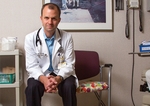profession
Has participatory medicine's time arrived? (AAFP annual scientific assembly)
■ Family physicians are urged to restructure their practices to get patients involved in making medical decisions and taking more responsibility for their health.
By Christine S. Moyer — Posted Nov. 8, 2010
- WITH THIS STORY:
- » Alzheimer's affects 200,000 people younger than 65
- » Treatment tips
- » External links
- » Related content
For years, family physician Edward Shahady, MD, instructed his diabetic patients to lower their hemoglobin A1c and blood pressure levels. He warned them about potential complications, sent them to nutritionists and educated them about the disease.
Still, levels remained elevated in at least half of his patients, leaving the doctor frustrated.
"We did everything we could in the exam room, and it wasn't getting results," said Dr. Shahady, of Fernandina Beach, Fla., medical director of the Diabetes Master Clinician Program of the Florida Academy of Family Physicians. "We had to try something different."
He started holding group medical visits, stopped telling patients what to do and began partnering with them. Together, Dr. Shahady and his patients have discussed toppling barriers to better health and created individual goals and plans.
The group visits have improved the glucose and blood pressure levels of his patients. And that success has given Dr. Shahady a great sense of satisfaction.
This approach to participatory medicine, in which doctors share decision-making responsibilities with their patients, has been explored for years but has not been practiced widely, experts say. But that is changing among physicians like Dr. Shahady.
One reason is the increasing prevalence of chronic disease, which requires long-term patient care. About half of U.S. adults had at least one chronic condition in 2005, according to the most recent data from the Centers for Disease Control and Prevention. Experts say involving patients in their care improves health outcomes, particularly for chronic illnesses.
For example, a 2000 Medical Care study found that participatory decision-making occurred in an average of 25% of family physician visits in Ohio. Appointments involving chronic disease were more likely than others to demonstrate shared decision-making.
At the American Academy of Family Physicians Scientific Assembly from Sept. 29 to Oct. 2 in Denver, medical experts urged doctors to restructure their patient relationships to allow patients to take more responsibility for their health and be more involved in treatment decisions. Presenters offered physicians tips on how to engage patients more.
Partnering with patients
"We need to move to a paradigm where the physician is a partner with the patient," Boston internist Daniel Sands, MD, MPH, said during a session he led on how participatory medicine improves health care for patients.
He said Americans have been acculturated to think that it's the doctor's job to tell patients how to get better.
"But those of us who do primary care know that model can't work. The patient has to be engaged," said Dr. Sands, director of medical informatics for Cisco's Internet Business Solutions Group. He also is an internist at Beth Israel Deaconess Medical Center in Boston.
The idea of physicians partnering with patients to improve health outcomes is not new.
In fact, internist Ralph Snyderman, MD, chancellor emeritus for Health Affairs at Duke University, said the relationship between physician and patient historically has been a close one. But as medicine has become more technical and specialized during the past 30 years, patients began seeing different specialists for various conditions rather than relying on a single physician for care. The result has been a growing distance between patients and their doctors, he said.
The Institute of Medicine issued a report in 2001 that detailed ways to enhance the nation's health care system. Among the goals were making health care more patient-centered by implementing shared decision-making and giving patients "unfettered access to their medical records and clinical knowledge."
"In a sense [we have to] go back to the way medicine used to be practiced without giving up all of the progress we made," said Dr. Snyderman, a professor of medicine at Duke University School of Medicine. "It's one of the most obvious things in the world."
Reducing health risks
One technique to engage patients is motivational interviewing, in which physicians speak with patients constructively about reducing their health risks. The intent is to motivate patients to take responsibility for their health and create solutions to their medical issues. Patients then work with physicians to achieve certain goals.
People are more likely to change behavior if they verbalize their problem. A 2009 Journal of Clinical Psychology study found that using motivational interviewing is 10% to 20% more effective than no treatment. The technique is at least as effective, and potentially more effective, than other treatments such as cognitive-behavioral therapy and 12-step programs.
Frank Domino, MD, a family physician in Shrewsbury, Mass., recently began implementing the technique during office visits after years of telling patients to quit smoking or lose weight with little result.
Dr. Domino, a presenter at the AAFP meeting, said using the technique makes him less frustrated. "I feel more content saying [to patients], 'How do you want to address' " this health issue, he said.
Many patients are healthier. He estimates that motivational interviewing leads 30% to 35% of them to modify their behavior.
"That's much better than what I used to see. You could threaten, beg, plead, and maybe 5% to 10% of people would change," said Dr. Domino, a professor of family medicine and community health at the University of Massachusetts Medical School.
During the AAFP session, he detailed the steps of motivational interviewing: Establish a rapport with the patient and elicit conversation in which the individual discusses his or her interest in changing a specific behavior. Doctors should help patients see the difference between their current situation and their future health goal. Physicians should offer patients general advice, and an action plan can be created.
Physicians should ask patients open-ended questions about their health issues, Dr. Domino said. For example, instead of asking overweight patients if they want to lose weight, he suggested asking them how they feel about their weight.
Dr. Domino stressed that although motivational interviewing often is effective, physicians should not expect every health issue to be resolved after one office visit.
"We don't solve every problem in one day, one week, one month or one year," Dr. Domino told the Denver gathering. "We solve them over [the patient's] lifetime. That's something we need to accept -- there's no quick fix."
One medical visit might be spent discussing a patient's barriers to accomplishing a health goal, said family physician Melissa Gerdes, MD, medical director of Trinity Clinic-Whitehouse in Texas. Possible solutions and an action plan could be discussed at later appointments, said Dr. Gerdes, who led a session at the AAFP meeting on patient engagement in the medical home.
She said engaging patients does not take more time during office visits; it just forces physicians to use their time differently.
Treating chronic disease
Patient involvement is particularly important for people who have a chronic disease, said Dr. Shahady. Such patients are responsible for managing their conditions on a daily basis. If they don't understand the disease and if physicians don't know patients' barriers, the condition will not be controlled, he said.
A group visit is an effective way to empower such patients to manage their illness, Dr. Shahady told physicians at an AAFP session. In a group appointment, a physician and at least one other health professional meet with multiple patients for follow-up or routine care. Patients are educated and counseled on the disease and can share experiences with other patients.
Dr. Shahady reminded physicians not to lecture patients during group visits. Instead, he encouraged them to view themselves as coaches and the patients as their players.
"Be a partner," he said. "Lead the patient to where they can go."
He admitted that leading group visits can be intimidating initially, because physicians are accustomed to working with patients individually. For the first group session, he recommends that doctors invite patients they like to converse with and those who will be easy to treat.
Another method of engaging patients is to use satisfaction surveys to get feedback on relationships with physicians and the overall quality of their health care, said Dr. Gerdes, president of the Texas Academy of Family Physicians. Doctors can use the survey results as a guide to make changes that address patients' concerns.
Such changes can lead to greater patient satisfaction and involvement, she said.
Using technology is another way to involve patients more, Dr. Gerdes said. For example, she sometimes uses a laptop to plot a patient's weight from a series of years on a graph to better show weight gain or loss.
Physicians who practice participatory medicine note that these techniques do not always lead to better health outcomes.
Some patients with diabetes continue to struggle with elevated hemoglobin A1c levels despite group visits. Motivational interviewing does not result in all smokers quitting the habit.
But doctors insist that engaging their patients in the process makes a difference.
"The answer to being healthy, in part, is patients taking responsibility [for] their own health," Dr. Gerdes said. "To do that, they need to be partners."












